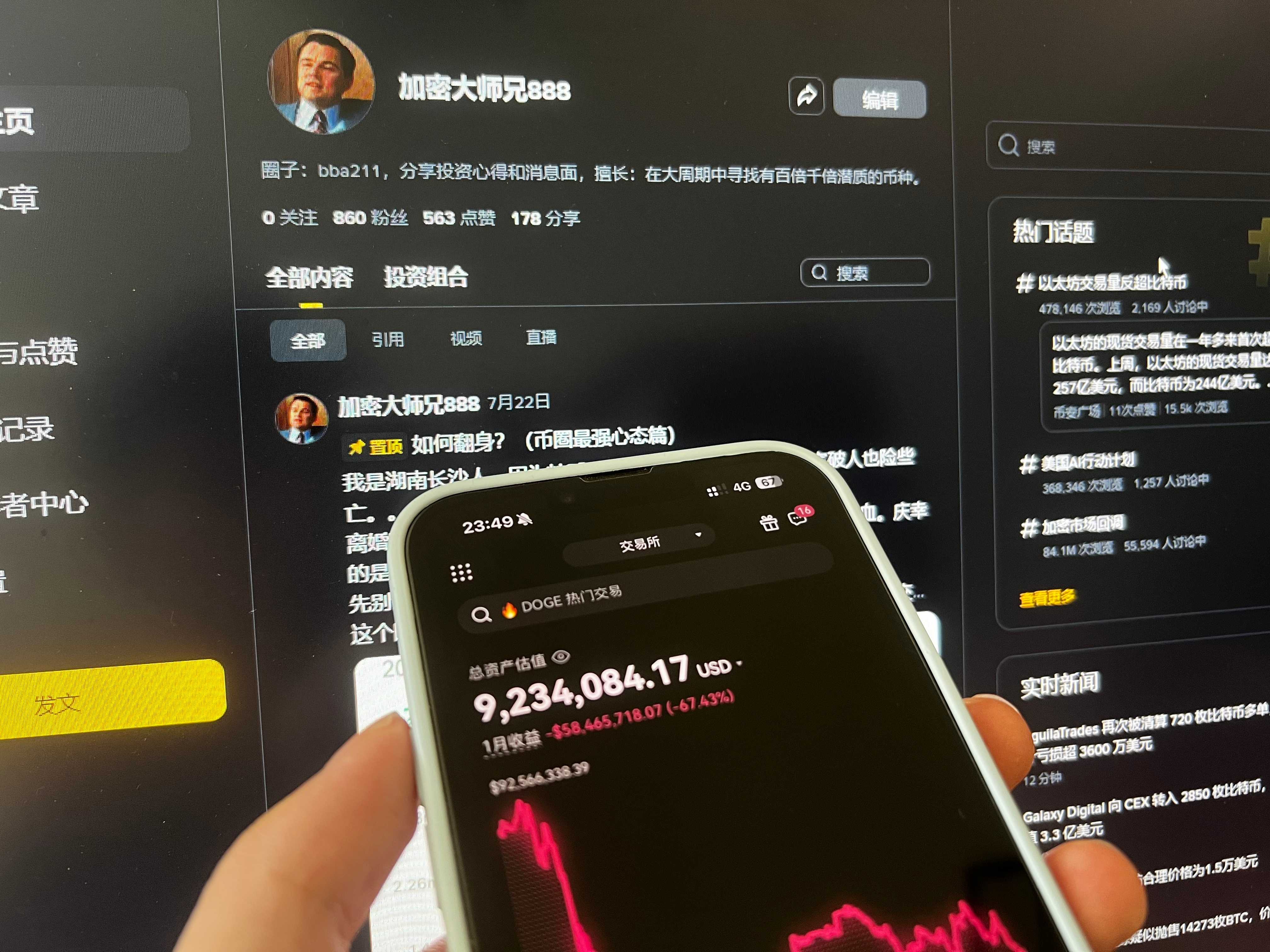In the unique field of cryptocurrency trading that operates 24/7, many traders often find themselves unable to sleep at night due to severe price fluctuations, even during the late hours. This potential for sudden large fluctuations makes risk control a crucial part of cryptocurrency trading. The essence of trading is not to operate frantically without rules but to have immense patience to wait for the right opportunity. If you're constantly staring at the market with a restless mind, it's easy to lose focus, leading to accelerated losses.

Here, I share 5 practical tips to help you avoid detours in the cryptocurrency space:
Trend trading with pullbacks: When a trend looks favorable, do not rush to enter at a high price. Be patient and wait for the price to pull back to a suitable level; entering at this time can lower costs and enhance trading safety. In an upward trend, a pullback often signals a brief market adjustment, and after the pullback reaches the target, the likelihood of continuing to rise is greater.
Trading in a range: In a ranging market, chasing prices up and down is a big no-no. A wise approach is to wait until the price reaches the high or low points of the range before taking action. When the price approaches the high point, consider selling; when it drops to the low point, consider buying. This approach can significantly increase the success rate of trades, as the characteristic of a ranging market is that prices fluctuate within a certain range.
Catching rebounds with volume: If you want to seize a rebound opportunity, do not blindly bottom fish. Closely monitor market trading volume; only when a volume increase signal appears is it a more reliable entry timing. Increased volume indicates active market participation, providing stronger momentum for rebounds. Confirm the rebound signal before entering to effectively avoid the risk of catching a falling knife.
Breakthroughs and pullbacks: When facing a breakthrough market, do not rush to chase the price increase. Usually, after the price breaks through an important resistance level, there will be a pullback to confirm support. Wait for the pullback to succeed and confirm the support is valid before entering the market, as this will make trading more stable. This is because a pullback can test the validity of the breakthrough; if the pullback does not break the support level, it indicates that the breakthrough has gained market recognition, increasing the likelihood of further price increases.
Bottom fishing and reversals: When attempting to bottom fish, one must not blindly enter based on subjective guesses. It is essential to wait for clear reversal signals to appear, such as distinct bottom reversal patterns in K-line formations or clear buy signals from technical indicators. Only then can one effectively avoid entering the market prematurely during a downtrend and getting trapped.
Having navigated the cryptocurrency space for years, I have experienced the despair of liquidation and the joy of doubling my investments. Today, I openly share the invaluable experiences gained from real trading losses, sincerely hoping to help every friend in the cryptocurrency community. I suggest everyone bookmark this for future reference.
1. Choose the right trading time; avoid daytime 'minefields'.
During the day, the cryptocurrency market resembles a chaotic 'information war', with false positive and negative news flooding in, causing erratic price movements that are difficult to predict. In such situations, investors can easily fall into traps of being lured into buying or selling.
Therefore, it is recommended to avoid the chaotic daytime situation as much as possible and choose to trade after 9 PM. At this point, the market information has largely stabilized, K-line formations are clearer, and directional judgments are more accurate. Trading during this time is like adding a 'safety lock' to your trades, effectively reducing the probability of making erroneous decisions due to information interference.
2. Lock in profits; don't let profits 'fly away'.
'Wanting to earn more after making a profit' is the root cause of many losses in the cryptocurrency space. In cryptocurrency investment, one must not fantasize about doubling assets; locking in profits in a timely manner is the true path to investing.
The specific operation method is as follows: For example, if you made a profit of 1000U from trading that day, you could immediately withdraw 300U to your bank card, and reinvest the remaining funds. In the cryptocurrency world, many people are not satisfied after tripling their profits, always thinking about making 5 times more, but a single market correction can result in total loss. It’s important to understand that only when the money is truly in your wallet is it considered real profit.
3. Let indicators do the talking; reject 'knee-jerk' decisions.
Making trading decisions solely based on intuition or feelings is akin to gambling. To enhance the scientific nature of trading decisions, I recommend a practical trading tool—TradingView. When using this tool, focus on the following 3 key indicators:
MACD: When the MACD indicator shows a golden cross, it's usually a bullish signal, indicating that the price may rise; when a death cross appears, it's a bearish signal, suggesting that the price may drop.
RSI: When the RSI indicator value is greater than 70, the market is in an overbought state, and a correction may be imminent; when the indicator value is less than 30, the market is in an oversold state, and it’s a good time to pay attention to rebound opportunities.
Bollinger Bands: When the Bollinger Bands narrow, it indicates that market volatility may be about to increase; when the price breaks above the upper band, it's a bullish signal; when the price breaks below the lower band, it's a bearish signal.
In actual trading, it’s important to follow a key principle: at least two indicators must provide consistent signals before considering entering a trade. This approach can effectively reduce the probability of making mistakes and increase the success rate of trading.
4. Stop losses must be 'alive'; preserving capital is the bottom line.
During the monitoring process, learn to flexibly adjust the stop-loss price. For example, if you bought a cryptocurrency for 1000U, when the price rises to 1100U, you should immediately raise the stop-loss price to 1050U, locking in a profit of 50U. If you cannot monitor the market constantly, you can set a 3% hard stop-loss. This measure can effectively prevent sudden crashes from wiping out your funds, as long as your principal remains, there will always be opportunities for recovery.
5. Mandatory weekly withdrawals; reject digital games.
If the numbers in your account are not withdrawn, they will forever remain just illusory figures. My personal habit is to transfer 30% of my profits to my bank card every Friday, using the remaining funds for rolling operations. Long-term adherence to this approach not only makes your wallet genuinely fuller but also allows your account balance to grow steadily, significantly relieving psychological pressure.
6. K-line usage guide: Find the right entry timing.
Short-term trading: For short-term traders, closely monitor the 1-hour chart. When two consecutive bullish candles appear, consider going long, as this often signals a price increase in the short term.
Filtering market conditions: If you want to filter for more suitable entry timing, switch to the 4-hour chart. Enter the market when the price drops near the support level; this makes bottom fishing safer. This is because on the 4-hour chart, the identification of support and resistance levels is more accurate, providing more reliable grounds for trading.
7. Avoid these pitfalls!
Leverage: When trading with leverage, do not exceed a leverage ratio of 50 times. The higher the leverage, the greater the risk; if the market judgment is wrong, losses will be magnified.
Cryptocurrency types: Stay away from Dogecoin, Shitcoins, and other altcoins. These cryptocurrencies are often highly controlled by big players, making it difficult for investors to obtain fair trading opportunities, and a slight misstep could lead to being harvested by the manipulators.
Frequency: The maximum number of trades per day should not exceed 3. Frequent trading can lead to emotional trading, losing rational judgment, thus increasing the probability of making mistakes.
Capital: Never borrow money to trade cryptocurrencies. Using money you can't afford to lose for cryptocurrency investment can lead to unbearable consequences if losses occur.
Trading cryptocurrencies means repeatedly doing simple things; consistently using one method over a long time can lead to mastery. Trading can become as skillful as in other industries, where practice makes perfect, allowing one to make each decision without overthinking.

This year marks my 17th year in cryptocurrency trading. I entered the market with 10,000 yuan, and now I'm supporting my family through trading! I can say that I've tried 80% of the methods and techniques in the market. If you want to treat cryptocurrency trading as a second career to support your family, sometimes listening more and observing can reveal insights beyond your current understanding, helping you avoid 5 years of detours!
Follow me @加密大师兄888 to keep up with trends and become wealthy together! Bulls and bears coexist.


